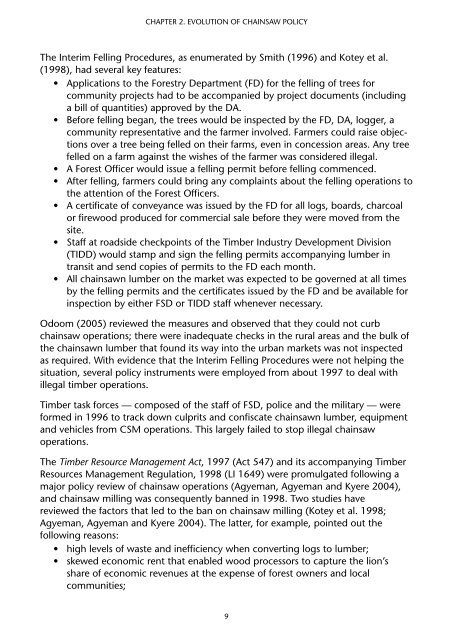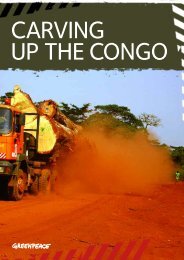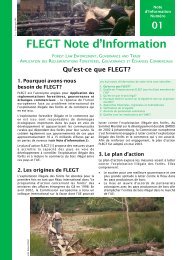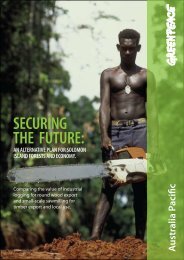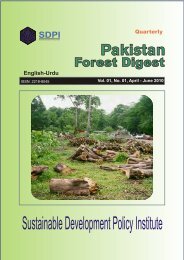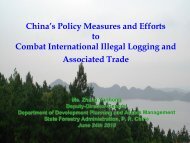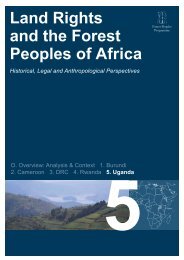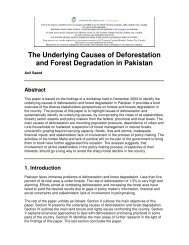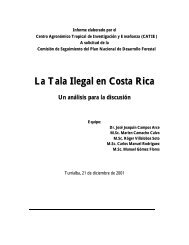Chainsaw milling in Ghana: context, drivers and impactsTable 3 (continued): Definition of legal timber in GhanaprocessingoperationsAct 571Act 571, NRCD243, Cap 110Act 571, NRCD243, Cap 110Timber companies require valid registration with the FC.Mills must follow safety and industrial processing standardsand trade guidelines during their processing operations.Mills cannot process chainsawn lumber. Logs to beprocessed must be covered by the necessary documentsand certificates such as conveyance certificates.markets andexportAct 571, SMCD128, NRCD 243,NRCD 273, LI1649Timber to be exported must be marked with the logger’svalid property mark and markings on logs or timber cannotbe defaced.All dealers (including exporters) require a valid registrationlicence to market timber.Export permits must be available during pre-shipmentinspections and examination of timber and wood products.fiscal regime Acts 124, 493, All tax obligations of a TUC holder must be fully met.547, NRCD 273,Cap 136, LoggingManualLoggers cannot be in arrears with respect to payment offees and charges.Loggers must pay all stumpage fees with respect toharvested trees.Source: Adapted from Agyeman, Oduro and Gyan 2007By 1994 both timber companies and chainsaw operators carried out excessive andoften uncontrolled felling in concession areas, making the regulations practicallyirrelevant. The situation was compounded by the various regulations issued separatelyby FSD and DAs. Chainsaw operators, DAs, farmers, and land-owners tookadvantage of the confusion and carried out much unmonitored felling. Speculativefelling and trade malpractice were widespread, including illegal trading in propertymarks and unauthorised subletting of concessions to unlicensed timber operators.The timber industry’s failure to pay royalties and other statutory fees for trees felled inboth reserve and off-reserve forests also reached serious proportions. There appearedto be an almost complete lack of control over timber harvesting in the off-reserveareas, where illegal production had risen to about 80% of total timber production(Kotey et al. 1998).2.2 Policy responsesIn response to these problems, a national working group was set up in 1994 torecommend strategies to control illegal felling outside forest reserves. It consisted ofthe National Chainsawyers Association, timber companies, local timber task forces(FSD, concession holders, district assemblypersons, villages and military personnel),District Chief Executives, FSD District Forest Managers, stool chiefs and traditionalauthorities, farmers and communities and the Forestry Ministry (now the Ministryof Lands and Natural Resources). A number of interim measures were consequentlyadopted, one of which was the Interim Felling Procedures of 1995.8
Chapter 2. Evolution of chainsaw policyThe Interim Felling Procedures, as enumerated by Smith (1996) and Kotey et al.(1998), had several key features:• Applications to the Forestry Department (FD) for the felling of trees forcommunity projects had to be accompanied by project documents (includinga bill of quantities) approved by the DA.• Before felling began, the trees would be inspected by the FD, DA, logger, acommunity representative and the farmer involved. Farmers could raise objectionsover a tree being felled on their farms, even in concession areas. Any treefelled on a farm against the wishes of the farmer was considered illegal.• A Forest Officer would issue a felling permit before felling commenced.• After felling, farmers could bring any complaints about the felling operations tothe attention of the Forest Officers.• A certificate of conveyance was issued by the FD for all logs, boards, charcoalor firewood produced for commercial sale before they were moved from thesite.• Staff at roadside checkpoints of the Timber Industry Development Division(TIDD) would stamp and sign the felling permits accompanying lumber intransit and send copies of permits to the FD each month.• All chainsawn lumber on the market was expected to be governed at all timesby the felling permits and the certificates issued by the FD and be available forinspection by either FSD or TIDD staff whenever necessary.Odoom (2005) reviewed the measures and observed that they could not curbchainsaw operations; there were inadequate checks in the rural areas and the bulk ofthe chainsawn lumber that found its way into the urban markets was not inspectedas required. With evidence that the Interim Felling Procedures were not helping thesituation, several policy instruments were employed from about 1997 to deal withillegal timber operations.Timber task forces — composed of the staff of FSD, police and the military — wereformed in 1996 to track down culprits and confiscate chainsawn lumber, equipmentand vehicles from CSM operations. This largely failed to stop illegal chainsawoperations.The Timber Resource Management Act, 1997 (Act 547) and its accompanying TimberResources Management Regulation, 1998 (LI 1649) were promulgated following amajor policy review of chainsaw operations (Agyeman, Agyeman and Kyere 2004),and chainsaw milling was consequently banned in 1998. Two studies havereviewed the factors that led to the ban on chainsaw milling (Kotey et al. 1998;Agyeman, Agyeman and Kyere 2004). The latter, for example, pointed out thefollowing reasons:• high levels of waste and inefficiency when converting logs to lumber;• skewed economic rent that enabled wood processors to capture the lion’sshare of economic revenues at the expense of forest owners and localcommunities;9
- Page 1: Chainsaw Millingin GhanaContext, dr
- Page 4 and 5: The mission of Tropenbos Internatio
- Page 6: Chapter 4. Drivers of chainsaw mill
- Page 12 and 13: Chainsaw milling in Ghana: Context,
- Page 14 and 15: Chainsaw milling in Ghana: Context,
- Page 16 and 17: Chainsaw milling in Ghana: context,
- Page 18 and 19: Chainsaw milling in Ghana: context,
- Page 20 and 21: Chainsaw milling in Ghana: context,
- Page 24 and 25: Chainsaw milling in Ghana: context,
- Page 26 and 27: Chainsaw milling in Ghana: context,
- Page 28 and 29: Chainsaw milling in Ghana: context,
- Page 30 and 31: Chainsaw milling in Ghana: context,
- Page 32 and 33: Chainsaw milling in Ghana: context,
- Page 34 and 35: Chainsaw milling in Ghana: context,
- Page 36 and 37: Chainsaw milling in Ghana: context,
- Page 38 and 39: Chainsaw milling in Ghana: context,
- Page 40 and 41: Chainsaw milling in Ghana: context,
- Page 42 and 43: Chainsaw milling in Ghana: context,
- Page 44 and 45: Chainsaw milling in Ghana: context,
- Page 46 and 47: Chainsaw milling in Ghana: context,
- Page 48 and 49: Chainsaw milling in Ghana: context,
- Page 50 and 51: Chainsaw milling in Ghana: context,
- Page 52 and 53: Chainsaw milling in Ghana: context,
- Page 54 and 55: Chainsaw milling in Ghana: context,
- Page 56 and 57: Chainsaw milling in Ghana: context,
- Page 58: Chainsaw milling in Ghana: context,
- Page 61 and 62: Chapter 6Conclusions and policyreco
- Page 63 and 64: Chapter 6. Conclusions and policy r
- Page 65 and 66: Chapter 6. Conclusions and policy r
- Page 67 and 68: Chapter 6. Conclusions and policy r
- Page 69 and 70: Endnotes1. The actual amount of waw
- Page 71 and 72: ReferencesAyine, A.D. 2008. Develop
- Page 73 and 74:
ReferencesOpoku, K. 2006. Forest Go
- Page 75 and 76:
Annex 1average size of haulagecrewn
- Page 77:
AcronymsAAC Annual allowable cutCE


